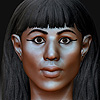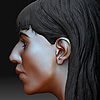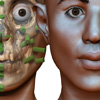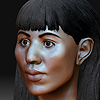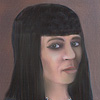The Face of Meresamun
The Oriental Institute commissioned two reconstructions of the face of Meresamun. Both artists worked from a three-dimensional image of the skull created from multiple CT scans and they did not compare their results while they worked.
Chicago artist Joshua Harker used the traditional forensic method in which layers of fat and muscle are built up upon the skull employing the Gatliff-Snow American Tissue Depth Marker Method. Harker superimposed layers of fat, muscle, and flesh upon the skull to build up Meresamun’s appearance. Rather than using a physical reproduction of a skull milled from CT scans, he worked digitally in three-dimensions. More of Harker’s work can be seen at www.joshharker.com.
The second reconstruction is by Michael Brassell, who was trained in forensic facial imaging by the Federal Bureau of Investigation. He works with the Department of Justice/Maryland State Police Missing Persons Unit on the project dubbed NamUs (www.namus.gov/), a database organized by the National Institute of Justice and the Department of Justice that allows smaller police departments and families of missing persons to try to identify skeletal remains.
The similarities between the two reconstructions (the narrow chin, small mouth, prominent cheekbones and shape of the eyes) suggest that both techniques have created a reliable portrait of Meresamun, whose face was last seen 2,800 years ago.
Images
Video
View film of the stages of the reconstruction of Meresamun’s face (43 sec). Joshua Harker.

